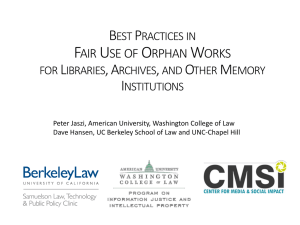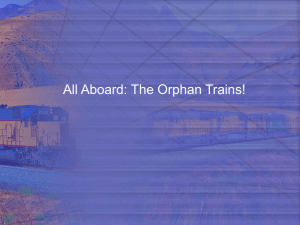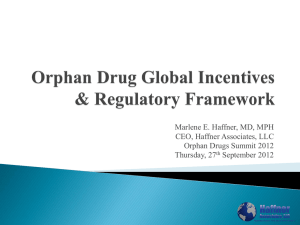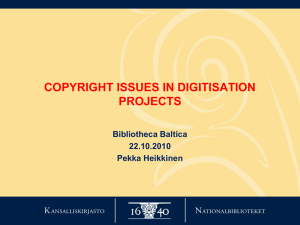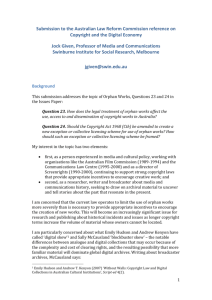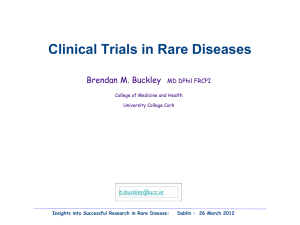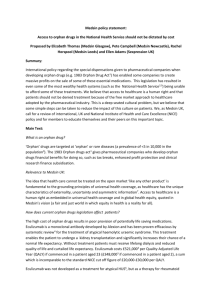Appraisal orphan drugs - Scottish Medicines Consortium
advertisement
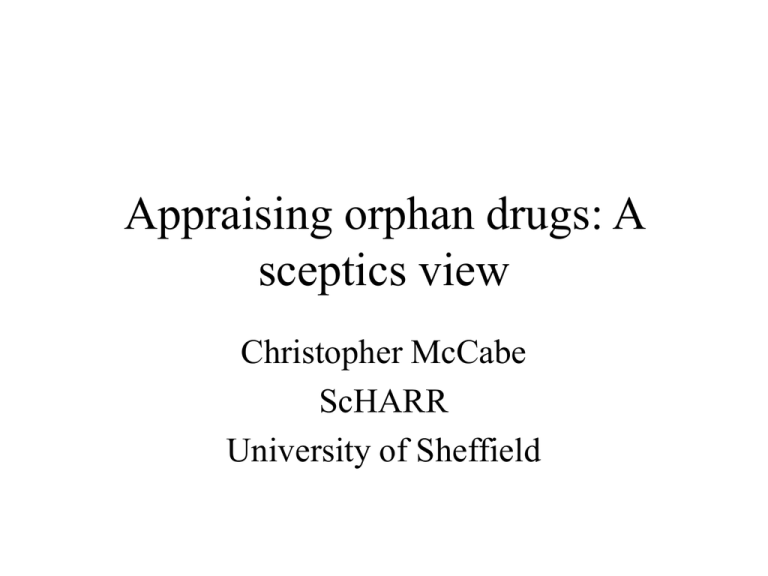
Appraising orphan drugs: A sceptics view Christopher McCabe ScHARR University of Sheffield Disclaimer What follows is my opinion alone. It draws on lengthy discussions with colleagues – notably Karl Claxton, Ron Akehurst and Aki Tsuchiya. The errors, of course, remain mine. I do not, cannot and will not speak on behalf of NICE. Here endeth the disclaimer! Peter is 35 years old, his life expectancy is 5 years. He is married with 2 children (a boy aged 5, and a girl aged 3). The symptoms of his disease mean that he is unable to maintain paid work, nor can he look after the children at home. As a result his wife has had to give up work in order to care for him and the children. There is no alternative treatment. The prevalence of his disease is 1 in 20,000 population. John is 35 years old, his life expectancy is 5 years. He is married with 2 children (a boy aged 5, and a girl aged 3). The symptoms of his disease mean that he is unable to maintain paid work, nor can he look after the children at home. As a result his wife has had to give up work in order to care for him and the children. There is no alternative treatment. The prevalence of his disease is 1 in 4,000 population. Should we value health gain to Peter more highly than health gain to John? Overview • • • • • What are orphan drugs Why some people think they are special (Our) Silver Lining (their pockets) A rationality test What was the problem that OD legislation attempted to address? • Issues for appraisal processes • Can we address these issues? What are orphan drugs? The United States Food and Drug Administration (FDA) and the European Medicines Evaluation Agency (EMEA), have defined orphan diseases as ones with a prevalence of @ 5 per 10,000 head of population. Examples of orphan diseases include: • • • • Huntingdon’s disease (1:20,000) Haemophilia B (1:25,000) Motor Neurone Disease (1:25,000) Variant CJD (1:10,000,000) Why some people think they special “Because so few individuals are affected by any one rare disease or condition, a pharmaceutical company which develops an orphan drug may expect the drug to generate relatively small sales in comparison to the cost of developing the drug and consequently to incur a financial loss. There is reason to believe that some promising orphan drugs will not be developed unless changes are made in the applicable federal laws to reduce the costs of developing such drugs and to provide financial incentives to develop such drugs; and it is in the public interest to provide such changes and incentives for the development of orphan drugs.” US Food and Drug Administration “Some conditions occur so infrequently that the cost of developing and bringing to the market a medicinal product to diagnose, prevent or treat the condition would not be recovered by the expected sales of the medicinal product; the pharmaceutical industry would be unwilling to develop the medicinal product under normal market conditions….patients suffering from rare conditions should be entitled to the same quality of treatment as other patients….” European Union Regulation 141/2000 Three arguments are being advanced: 1. Financial viability of production of evidence base for clinical efficacy 2. Equality of potential treatment for all patients 3. Definition of high quality health care in terms of pharmaceutical therapies. Silver Lining Orphan drugs are given preferential treatment: • In Research and Development; through additional tax incentives and direct funding. • In licensing; through the acceptance of lower levels of evidence (within a frequentist paradigm); and • In the market, through market exclusivity for up to 10 years. • i.e. public money is put into the Research and Development process; • The risk to the pharmaceutical company’s investment is reduced; and • The return on the investment is maximised through the creation of a legal monopoly. And • The public don’t get any return on their investment. A rationality test Ask yourselves the following question: Would it be correct to spend $800,000,000 to develop a drug to treat a disease from which only one person suffers? YES or NO • If you answered ‘No’ then you have accepted the concept of rationing in the context of orphan diseases. – Now we just need to work out the parameters of our rationing system • If you answered ‘yes’; now might be a good time to leave because you wont like what follows. Another question: Should we encourage companies to invest in the development of therapies; where the cost of production exceeds the value we place on that health gain? YES or NO If you answered ‘No’; then the cost of development & production argument for treating orphan diseases differently can be ignored. If you answered ‘yes’; you have let your dislike of the pharmaceutical industry get out of hand! What was the problem OD legislation attempted to address? • Treatments for some diseases will never be developed in free market conditions. • Why? – – – – – – Size of market Cost of Research and Development Cost of distribution Cost of administration to patient Willingness (and ability) to pay for health Evidential hurdles • Why focus on market size? – This is a very poor proxy for a very complex function – The function of interest is the investment function for experimental pharmaceutical therapies • If the probability of investment is low, due to any combination of investment parameters; the case for ‘special treatment’ should be the same. – But • It is not simply about low investment potential The problem • A sense that individuals should not be left without any hope of health care – Observed WTP for public health care suggests that society is truly altruistic in this regard. • Can we assume drug therapy and health care are equivalent in this regard? – Palliative care – doubtful – Disease modifying care - possibly • Would society’s desire to provide health care to all extend to ensuring the possibility of disease modifying health care? – This is an empirical question – Note, this argument only applies where there is no alternative disease modifying therapy. • So, for special treatment consistent with the problem identified by the OD legislation we need two conditions: – Low investment potential – No alternative disease modifying therapy To be clear ….. The OD legislation is a very poor solution to the problem it claims to address Issues for Appraisal processes • Can orphan drugs be appraised? – Given the evidence base for orphan drugs, can they be subjected to comparably robust analysis? • Yes – but only in a Bayesian Decision Analytic Framework Appraising rare diseases: the DA Framework • Decision analytic models calculate the expected costs and outcomes of alternative courses of actions using the ideas of choices, probability and pay-offs. • A decision is made on the balance of probability, using the expected outcomes; with uncertainty explicitly acknowledged. • Additional research is only of value to the degree that it reduces uncertainty and thereby the cost of making the wrong decision. • The cost of making a wrong decision is a function of the size of the population to be treated. • For rare diseases the value of further research is less than for prevalent diseases; ceteris paribus. – Decision analysis accepts lower standards of evidence (i.e. more uncertainty) for rare diseases. • Therefore the costs of meeting the evidential criteria for appraisal do not have to be a threat to provision of treatments for rare diseases. Issues for appraisal contd. • Orphan drugs will not be cost effective given existing thresholds and case law. – This is a political problem – And/or a commercial decision • Orphan drugs are potentially very expensive – New enzyme replacement therapies may cost in excess of £150K per person per year – There are between 3,000 and 5,000 orphan diseases – This issue can bankrupt the NHS Should orphan drugs get special treatment ? Valuing the benefits of orphan drugs • We want treatments for rare conditions; conditional upon their cost being no greater than the value we place on the health gain they produce. • How do much do we value treatments for people with rare conditions? • Consider Peter and John • Is rarity a good basis for an equity weight? – How about existence of an alternative treatment? – Having dependents – Limited capacity for health – Age • These can be treated as empirical questions – NICE/NCCR&D Social QALY project Characteristics of a special case • Let me get back to you….. C-E threshold or Equity-weighted QALYs – an aside • Some may argue for a higher C-E threshold for orphan drugs – this is wrong; – The threshold is our best guess of the cost per QALY of the activities which will be displaced. – It will not be affected by the value we place on the health gain from an orphan drug. • We may value the benefit from an orphan drug differently – therefore, we should weight the QALY. Non-commercial diseases – an aside • Legislation promoting orphan diseases, rather than non-commercial diseases more generally, may not be as ethical and altruistic as it first appears. – It is easier to protect a monopoly which serves a small number of people, than one which serves large numbers of people. Risks of special status • Incentives to industry to reclassify drugs (and diseases) • Scope of pharmacogenomics to reclassify diseases. • Lower standard of evidence creating a retirement home for failed therapies. Can we address these issues • Yes • Redefine orphan drugs for appraisal purposes in terms of the investment function and the existence of disease modifying therapy • Where this analysis establishes that a drug is an orphan – additional QALY weight may be considered. • Test empirically whether society would give additional weight when there is no alternative disease modifying therapy. – If yes; obtain quantitative estimate. • Monetize this value Subtract value of tax breaks already provided • Remainder is the extent of additional value which appraisal process should consider. – Caveat – a therapy with multiple potential indications must have low investment potential across the total; and at be the only disease modifying therapy for at least one of these indications. A cautionary tale • The introduction of renal dialysis to US in the late 1960’s was a very hot political issue. – The patient lobby arranged for a patient to give evidence to congress whilst being dialysed. – Congress approved the coverage of dialysis costs under the US Medicare programme. – In 1972 this was predicted to cost $200 million per annum in the year 2000. – In the year 2000, Medicare spent over $4 billion on dialysis treatment. • Open-ended commitments are a strong incentive to the pharmaceutical industry. • A simplistic interpretation of the orphan drug status in the context of appraisal might create such an open-ended commitment. A modest proposal • First; lets be explicit: – there is no open-ended commitment to fund any therapy – promoting investment in developing therapies which cannot produce health gain at an affordable price is wrong – Equality of treatment is not synonymous with the guaranteed availability of drug therapy – Appraisals should support the provision of therapies which produce health gain which is valued at least as highly as the activities which are displaced. • Second; lets find out: – What factors influence the value we place on health gain; • Either characteristics of the disease; or • Characteristics of the recipient of the treatment – Then incorporate these data into our decision analyses. • Finally: – Lets place the development and appraisal of new therapies in the decision framework; – That way, rare diseases will be given the special treatment they deserve…. – And no more than they deserve!
